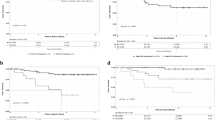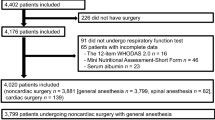Abstract
Purpose
Patients with impaired functional capacity who undergo major surgery are at increased risk of postoperative morbidity including complications and increased length of stay. These outcomes have been associated with increased hospital and health system costs. We aimed to assess whether common preoperative risk indices are associated with postoperative cost.
Methods
We conducted a health economic analysis focused on the subset of Measurement of Exercise Tolerance before Surgery (METS) study participants in Ontario, Canada. Participants were scheduled for major elective noncardiac surgery and underwent several preoperative assessments of cardiac risk, including physicians’ subjective assessment, Duke Activity Status Index (DASI) questionnaire, peak oxygen consumption, and Nterminal proBtype natriuretic peptide concentration. Using linked health administrative data, postoperative costs were calculated for both one year and in-hospital. Using multiple regression models, we tested for association between the preoperative measures of cardiac risk and postoperative costs.
Results
Our study included 487 patients (mean [standard deviation] age 68 [11] yr and 47.0% female) who underwent noncardiac surgery between 13 June 2013 and 8 March 2016. Overall, the median [interquartile range] cost incurred within one year postoperatively was CAD 27,587 [13,902–32,590], of which CAD 12,928 [10,253–12,810] were incurred in-hospital and CAD 14,497 [10,917–15,017] were incurred by 30 days. None of the four preoperative measures of cardiac risk assessment were associated with costs incurred in hospital or at one year postoperatively. This lack of strong association persisted in sensitivity analyses considering type of surgical procedure, burden of preoperative cost, and when costs were categorized as quantiles.
Conclusion
In patients undergoing major noncardiac surgery, common measures of functional capacity are not consistently associated with total postoperative cost. Until further data exist that differ from this analysis, clinicians and health care funders should not assume that preoperative measures of cardiac risk are associated with annual health care or hospital costs for such surgeries.
Résumé
Objectif
La patientèle présentant une capacité fonctionnelle dégradée qui bénéficie d’une intervention chirurgicale majeure court un risque accru de morbidité postopératoire, y compris de complications et de prolongation de la durée de séjour. Ces issues ont été associées à une augmentation des coûts hospitaliers et du système de santé. Notre objectif était d’évaluer si des indices de risque préopératoires communs étaient associés aux coûts postopératoires.
Méthode
Nous avons effectué une analyse de l’économie de la santé axée sur le sous-ensemble des participant·es à l’étude METS (Measurement of Exercise Tolerance before Surgery) en Ontario, au Canada. Les participant·es devaient bénéficier d’une chirurgie non cardiaque et non urgente majeure et ont complété plusieurs évaluations préopératoires du risque cardiaque, notamment l’évaluation subjective des médecins, le questionnaire DASI (Duke Activity Status Index), la consommation maximale d’oxygène et la concentration de prohormone N-terminale du peptide natriurétique de type B (cérébral) (NT-proBNP). À l’aide de données administratives couplées de santé, les coûts postopératoires ont été calculés à la fois pour une année et à l’hôpital. À l’aide de modèles de régression multiples, nous avons testé l’association entre les mesures préopératoires du risque cardiaque et les coûts postopératoires.
Résultats
Notre étude a inclus 487 personnes (âge moyen [écart type] 68 [11] ans et 47,0 % de femmes) ayant bénéficié d’une chirurgie non cardiaque entre le 13 juin 2013 et le 8 mars 2016. Dans l’ensemble, le coût médian [écart interquartile] engagé dans l’année qui a suivi l’opération était de 27 587 CAD [13 902–32 590], dont 12 928 CAD [10 253–12 810] ont été encourus à l’hôpital et 14 497 CAD [10 917–15 017] ont été encourus dans les premiers 30 jours. Aucune des quatre mesures préopératoires de l’évaluation du risque cardiaque n’était associée aux coûts engagés à l’hôpital ou un an après l’opération. Cette absence d’association forte persistait dans les analyses de sensibilité tenant compte du type d’intervention chirurgicale, du fardeau des coûts préopératoires et lorsque les coûts étaient classés en quantiles.
Conclusion
Chez la patientèle bénéficiant d’une chirurgie non cardiaque majeure, les mesures courantes de la capacité fonctionnelle ne sont pas systématiquement associées au coût postopératoire total. Jusqu’à ce qu’il existe d’autres données qui diffèrent de cette analyse, les cliniciens et cliniciennes et les organismes finançant les soins de santé ne devraient pas présumer que les mesures préopératoires du risque cardiaque sont associées aux coûts annuels des soins de santé ou des hôpitaux pour de telles chirurgies.


Similar content being viewed by others
Notes
SAS Institute Inc., Cary, NC, USA
References
Papanicolas I, Woskie LR, Jha AK. Health care spending in the United States and other high-income countries. JAMA 2018; 319: 1024–39. https://doi.org/10.1001/jama.2018.1150
Kaye DR, Luckenbaugh AN, Oerline M, et al. Understanding the costs associated with surgical care delivery in the Medicare population. Ann Surg 2020; 271: 23–8. https://doi.org/10.1097/SLA.0000000000003165
Fleisher LA, Fleischmann KE, Auerbach AD, et al. 2014 ACC/AHA guideline on perioperative cardiovascular evaluation and management of patients undergoing noncardiac surgery: a report of the American College of Cardiology/American Heart Association Task Force on Practice Guidelines. Circulation 2014; 130: e278–333. https://doi.org/10.1161/CIR.0000000000000106
Wilson RJ, Davies S, Yates D, Redman J, Stone M. Impaired functional capacity is associated with all-cause mortality after major elective intra-abdominal surgery. Br J Anaesth 2010; 105: 297–303. https://doi.org/10.1093/bja/aeq128
Snowden CP, Prentis JM, Anderson HL, et al. Submaximal cardiopulmonary exercise testing predicts complications and hospital length of stay in patients undergoing major elective surgery. Ann Surg 2010; 251: 535–41. https://doi.org/10.1097/SLA.0b013e3181cf811d
Vonlanthen R, Slankamenac K, Breitenstein S, et al. The impact of complications on costs of major surgical procedures: a cost analysis of 1200 patients. Ann Surg 2011; 254:907–913. https://doi.org/10.1097/SLA.0b013e31821d4a43
Healy MA, Mullard AJ, Campbell DA Jr, Dimick JB. Hospital and payer costs associated with surgical complications. JAMA Surg 2016; 151: 823–30. https://doi.org/10.1001/jamasurg.2016.0773
Wijeysundera DN, Pearse RM, Shulman MA, et al. Assessment of functional capacity before major non-cardiac surgery: an international, prospective cohort study. Lancet 2018; 391: 2631–40. https://doi.org/10.1016/S0140-6736(18)31131-0
Hlatky MA, Boineau RE, Higginbotham MB, et al. A brief self-administered questionnaire to determine functional capacity (the Duke Activity Status Index). Am J Cardiol 1989; 64: 651–4. https://doi.org/10.1016/0002-9149(89)90496-7
Struthers A, Lang C. The potential to improve primary prevention in the future by using BNP/N-BNP as an indicator of silent “pancardiac” target organ damage: BNP/N-BNP could become for the heart what microalbuminuria is for the kidney. Eur Heart J 2007; 28: 1678–82. https://doi.org/10.1093/eurheartj/ehm234
Wijeysundera DN, Pearse RM, Shulman MA, et al. Measurement of Exercise Tolerance before Surgery (METS) study: a protocol for an international multicentre prospective cohort study of cardiopulmonary exercise testing prior to major non-cardiac surgery. BMJ Open 2016; 6: e010359. https://doi.org/10.1136/bmjopen-2015-010359
Benchimol EI, Smeeth L, Guttmann A, et al. The REporting of studies Conducted using Observational Routinely-collected health Data (RECORD) statement. PLoS Med 2015; 12: e1001885. https://doi.org/10.1371/journal.pmed.1001885
Wodchis WP, Bushmeneva K, Nikitovic M, McKillop I. Guidelines on person-level costing using administrative databases in Ontario, 2013. Available from URL: https://hspn.ca/wp-content/uploads/2019/09/Guidelines_on_PersonLevel_Costing_May_2013.pdf (accessed February 2023).
Quan H, Sundararajan V, Halfon P, et al. Coding algorithms for defining comorbidities in ICD-9-CM and ICD-10 administrative data. Med Care 2005; 43: 1130–9. https://doi.org/10.1097/01.mlr.0000182534.19832.83
van Ingen T, Matheson FI. The 2011 and 2016 iterations of the Ontario Marginalization Index: updates, consistency and a cross-sectional study of health outcome associations. Can J Public Health 2022; 113: 260–71. https://doi.org/10.17269/s41997-021-00552-1
Schroeder SA. Shattuck lecture. We can do better--improving the health of the American people. N Engl J Med 2007; 357: 1221–8. https://doi.org/10.1056/NEJMsa073350
Harrell FE Jr. Regression Modeling Strategies: With Applications to Linear Models, Logistic Regression, and Survival Analysis, 2nd ed. New York: Springer; 2015.
Canadian Institute for Health Information. Patient cost estimator. Available from URL: https://www.cihi.ca/en/patient-cost-estimator (accessed February 2023).
Duceppe E, Parlow J, MacDonald P, et al. Canadian Cardiovascular Society guidelines on perioperative cardiac risk assessment and management for patients who undergo noncardiac surgery. Can J Cardiol 2017; 33: 17–32. https://doi.org/10.1016/j.cjca.2016.09.008
Duceppe E, Patel A, Chan MTV, et al. Preoperative N-Terminal Pro-B-Type natriuretic peptide and cardiovascular events after noncardiac surgery: a cohort study. Ann Intern Med 2020; 172: 96–104. https://doi.org/10.7326/M19-2501
Vascular Events in Noncardiac Surgery Patients Cohort Evaluation (VISION) Study Investigators, Spence J, LeManach Y, et al. Association between complications and death within 30 days after noncardiac surgery. CMAJ 2019; 191: E830–7. https://doi.org/10.1503/cmaj.190221
Yu P, Chang DC, Osen HB, Talamini MA. NSQIP reveals significant incidence of death following discharge. J Surg Res 2011; 170: e217–24. https://doi.org/10.1016/j.jss.2011.05.040
Author contributions
All authors contributed to the design of the study. The data collection and quality control were performed by Vatsal Trivedi and Karim S. Ladha. The data analysis was performed by all authors. The paper was drafted and approved by all authors.
Disclosures
Karim S. Ladha is a co-PI of an observational study on medical cannabis funded by Shoppers Drug Mart. This study contracted ICES Data & Analytic Services and used data from the ICES Data Repository, which is managed by ICES with support from its funders and partners: Canada’s Strategy for Patient Oriented Research (SPOR), the Ontario SPOR Support Unit, the Canadian Institutes of Health Research and the Government of Ontario. The opinions, results, and conclusions reported are those of the authors. No endorsement by ICES or any of its funders or partners is intended or should be inferred. Parts of this material are based on data and information compiled and provided by CIHI. Nevertheless, the analyses, conclusions, opinions, and statements expressed herein are those of the author, and not necessarily those of CIHI. Parts of this material are based on data and information provided by Cancer Care Ontario (CCO). The opinions, results, view, and conclusions reported in this paper are those of the authors and do not necessarily reflect those of CCO. No endorsement by CCO is intended or should be inferred.
Funding statement
Funding for administrative database coding and analysis was supported by a CIHR Grant for the Measurement of Exercise Tolerance before Surgery (METS) study. Duminda N. Wijeysundera is supported in part by the Endowed Chair in Translational Anesthesiology Research at St. Michael’s Hospital and the University of Toronto (Toronto, ON, Canada). Duminda N. Wijeysundera, Karim Ladha, and Brian H. Cuthbertson are supported in part by Merit Awards from the Department of Anesthesiology and Pain Medicine at the University of Toronto.
Editorial responsibility
This submission was handled by Dr. Stephan K. W. Schwarz, Editor-in-Chief, Canadian Journal of Anesthesia/Journal canadien d’anesthésie.
Author information
Authors and Affiliations
Corresponding author
Additional information
Publisher's Note
Springer Nature remains neutral with regard to jurisdictional claims in published maps and institutional affiliations.
Supplementary Information
Below is the link to the electronic supplementary material.
Supplementary file1 (PDF 122 KB)
eTable 1 Regression coefficient estimates of adjusted analysis represented as ratio of mean costs for one-year costs. eTable 2 Cost quantile regression estimates with estimated cost response at one year modelled as quartiles
Rights and permissions
Springer Nature or its licensor (e.g. a society or other partner) holds exclusive rights to this article under a publishing agreement with the author(s) or other rightsholder(s); author self-archiving of the accepted manuscript version of this article is solely governed by the terms of such publishing agreement and applicable law.
About this article
Cite this article
Trivedi, V., Ladha, K.S., Jivraj, N.K. et al. Association between preoperative cardiac risk assessment and health care costs in major noncardiac surgery: a multicentre health economic analysis. Can J Anesth/J Can Anesth 70, 1340–1349 (2023). https://doi.org/10.1007/s12630-023-02519-x
Received:
Revised:
Accepted:
Published:
Issue Date:
DOI: https://doi.org/10.1007/s12630-023-02519-x




